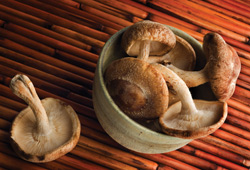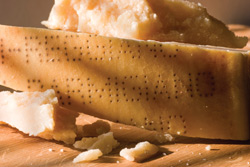The tongue can distinguish it, but trying to describe it in words is another story.
Umami. It’s not sweet, not salty, not bitter, nor sour. Something closer to savory, experts agree. Or a “pungent meaty.” Maybe “brothy.” The word translates to “delicious taste,” though the Japanese themselves often experience frustration trying to explain umami in English…
The declared “fifth taste” was discovered in 1908 by Kikunae Ikeda, a chemistry professor at the Imperial University of Tokyo. He found that monosodium glutamate was responsible for the previously indescribable palatability found in dishes like kombu dashi, a dried kelp broth, as well as in western staples like tomatoes, cheese and beef.
“Sometimes, individual amino acids have a taste,” explains Erica Bakota, a research chemist in the Functional Foods Research Unit at the USDA Ag Lab. “[Glutamate] has a flavor which is distinctly savory.” She says one reason umami officially qualifies as “the fifth taste” is that, like the other four, it’s not distinguished by the nose, but rather, by the tongue.
“It’s a phenomenon taking place on the receptors of the tongue. Studies have identified the specific genes for the receptors on the tongue that detect umami,” she says. Many foods contain the glutamate responsible for the savory flavor, but as it’s “incorporated into larger molecules” such as proteins, it often “loses its savory flavor,” she adds. “Therefore, it’s possible that large molecules containing glutamate would not have an umami taste.”
 Long story short, preparing umami dishes requires a careful attention to detail, from the choice of ingredients to portions and pairing. And recently, restaurants around the country have been incorporating umami into its dishes. The growing California-based Umami Burger offers a signature umami burger topped with shiitake mushrooms, caramelized onions, roasted tomato, parmesan crisp and “umami ketchup.”
Long story short, preparing umami dishes requires a careful attention to detail, from the choice of ingredients to portions and pairing. And recently, restaurants around the country have been incorporating umami into its dishes. The growing California-based Umami Burger offers a signature umami burger topped with shiitake mushrooms, caramelized onions, roasted tomato, parmesan crisp and “umami ketchup.”
Closer to home, Red Robin Gourmet Burgers in Chicagoland recently added an umami-flavored item to its menu: an appetizer of breaded mushrooms served with a Thai chile sauce. Corporate Chef Dave Wooley told Nation’s Restaurant News “the sweet-spicy combination goes well with the umami of mushrooms.” In addition, Frito-Lay, Campbell’s and other big-name producers have recently jumped aboard the umami ship.
But you don’t need to go out to find umami—it’s within your own reach at home. Start with basic ingredients containing high levels of monosodium glutamate: ham, parmesan cheese or shiitake mushrooms, to name a few. Consider pairing umami-rich flavors with other ingredients to enhance the taste. Combinations like roquefort cheese and port, truffles and parmesan, or beef with sun-dried tomatoes are a few “umami-nators.” If you achieve a savory “delicious taste,” odds are that’s umami—even if you have a tough time describing it. a&s
 Umami-Rich Foods
Umami-Rich Foods
The following foods contain high levels of naturally occurring glutamate (mg per 100g).
Kombu (Seaweed): 3,190
Parmesan Cheese: 1,200
Soy Sauce: 780
Green Tea: 668
Cured Ham: 337
Tomatoes: 246
Tuna: 188
Dried Shiitake Mushrooms: 150
Beef: 107
Potatoes: 102
Carrots: 33
Source: umamiinfo.com


